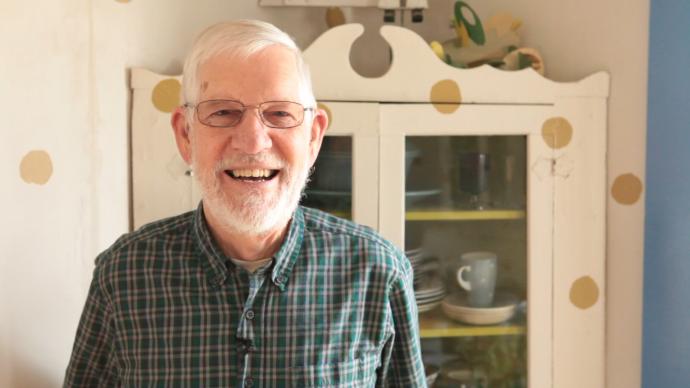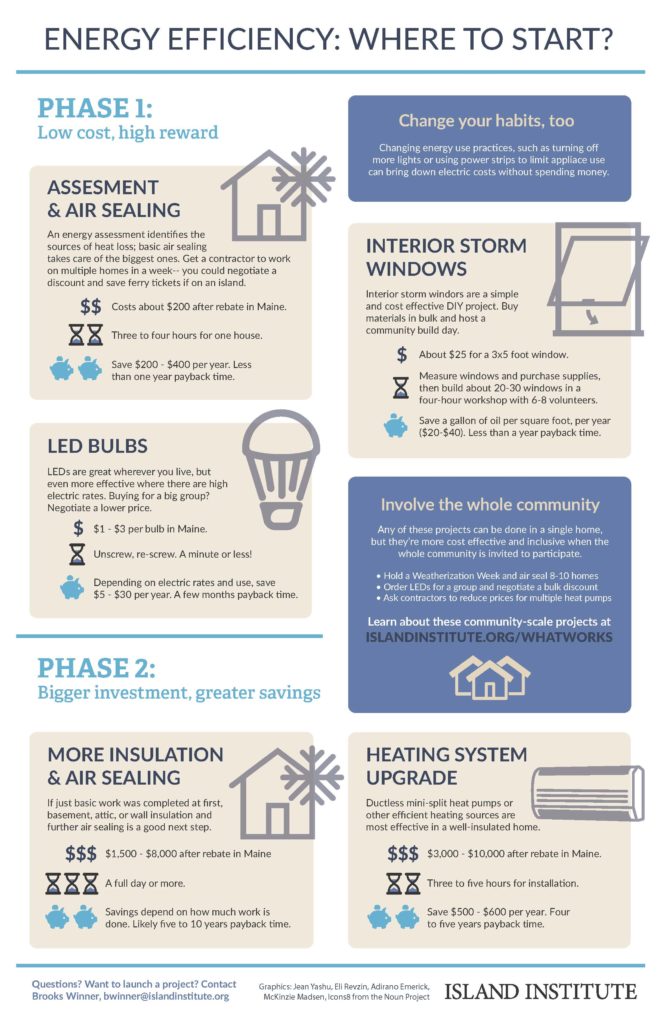HOW IT WORKS
Sam Saltonstall, a resident of Peaks Island in Casco Bay, Maine, had spent years trying to lower his own energy costs. #2 heating oil and propane are very costly on Peaks Island, making the winter heating season a financial hardship for many year-round residents. Sam organized a group of Peaks Island residents to purchase heat pumps in bulk. Heat pumps, which run on electricity—they function similarly to an air conditioner, but running in reverse—are cost-effective for communities with relatively affordable electric costs. Peaks is connected by a cable and serviced by a mainland utility, so its electricity rates are comparable to those on the mainland. At electricity prices above $0.35/kWh, heat pumps may no longer be cost effective. Contractors reduced the cost of the heat pump installation by $250, or about 7%, if eight or more homeowners signed up.
IMPLEMENTATION STEPS
Sam led the effort, with the help of other members of the Peaks Island electric club. They held meetings, organized sign-ups, and issued a request for proposals (RFP) to contractors.
- Hold an informational meeting to discuss the idea: the problem, the potential for heat pumps as a solution, and the economic advantage to purchasing in bulk.
- Leave lots of time for questions. This is going to be new for most people.
- Use a sign-up sheet so you can generate a list of potential customers at the very first meeting.
- Email follow-up to generate additional sign-ups.
- Issue an RFP (Here’s an example: to local contractors to generate bids.
- Share proposals, let residents create groups to work with selected contractors and then get out of the way: once the contractor and homeowners have agreed, let each individual handle the payment and scheduling with the contractor. This cuts down on miscommunication and administrative time.
Q & A WITH SAM SALTONSTALL, PEAKS ENVIRONMENTAL ACTION TEAM

How do heat pump installs differ from home to home?
One size does not fit all when it comes to heat pumps. There needs to be a lot of thinking involved in where they need to be installed. There might be electrical issues because you need a certain amount of circuitry available in your breaker panel. Where you site the heat pump and how long you need to run wires and how complicated that is can have an effect on the price. Prices tend to vary from the initial proposals from the contractors because there ends up being extra work that needs to be done.
Did homeowners have any issues or hurdles to get over?
There were a few minor complaints about the way the heat pumps worked. One person got a lemon and the contractors had to come back several times to try and fix it before they just took it out and installed another one. One customer had a heat pump that wasn’t pitched the right way so condensation was dripping on the floor. Another had a very old house and the wall where it was installed started to buckle. So there’s a real learning curve on the part of the contractors – these units were not being installed until just a few years ago. And there’s also a learning curve when the contractors have to know all the ins and outs of working on an island. Like, forgetting to have the parts you need.
Are there any concerns now that the heat pumps are installed?
Heat pumps will continue to get more efficient and continue to evolve, but right now the jury is out on how long they will last. If you ask a contractor for a conservative estimate of their lifespan, they might say 15 years but I think in the South where heat pumps have been used more for air conditioning, they can last longer, more like 20 to 25 years. So there’s concern that they’ll need to be replaced at some point, sooner rather than later.
How do heat pump installs differ from home to home?
One size does not fit all when it comes to heat pumps. There needs to be a lot of thinking involved in where they need to be installed. There might be electrical issues because you need a certain amount of circuitry available in your breaker panel. Where you site the heat pump and how long you need to run wires and how complicated that is can have an effect on the price. Prices tend to vary from the initial proposals from the contractors because there ends up being extra work that needs to be done.
OUTCOMES / RESULTS
- At $0.16/kWh, heat pumps cost about $1,500 per year to operate. Homeowners may save 30–40% over their previous heating system.
- At electricity prices above $0.35/kWh, heat pumps may no longer be cost effective.
- Maine’s average installation cost is $3,500. The contractors on Peaks reduced the price of each heat pump installation by about $250 for groups of eight or more homeowners, in addition to a $500 rebate from Efficiency Maine.
ADDITIONAL RESOURCES

Originally Published March 2016

